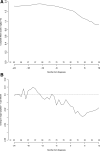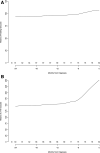C-Peptide Levels in Subjects Followed Longitudinally Before and After Type 1 Diabetes Diagnosis in TrialNet
- PMID: 32457058
- PMCID: PMC7372058
- DOI: 10.2337/dc19-2288
C-Peptide Levels in Subjects Followed Longitudinally Before and After Type 1 Diabetes Diagnosis in TrialNet
Abstract
Objective: Insulin secretion declines rapidly after diagnosis of type 1 diabetes, followed by a slower rate of change. Previous studies have demonstrated that the C-peptide decline begins before the clinical diagnosis. Changes in insulin secretion in the same individuals studied from preclinical stages through and after clinical diagnosis have not been previously reported.
Research design and methods: Antibody-positive relatives undergo sequential oral glucose tolerance testing (OGTT) as part of TrialNet's Pathway to Prevention study and continue both OGTT and mixed-meal tolerance testing (MMTT) as part of the Long-term Investigational Follow-up in TrialNet study if they develop type 1 diabetes. We analyzed glucose and C-peptide data obtained from 80 TrialNet subjects who had OGTT before and after clinical diagnosis. Separately, we compared C-peptide response to OGTT and MMTT in 127 participants after diagnosis.
Results: C-peptide did not change significantly until 6 months before the clinical diagnosis of type 1 diabetes and continued to decline postdiagnosis, and the rates of decline for the first 6 months postdiagnosis were similar to the 6 months prediagnosis. There were no significant differences in MMTT and OGTT C-peptide responses in paired tests postdiagnosis.
Conclusions: This is the first analysis of C-peptide levels in longitudinally monitored patients with type 1 diabetes studied from before diagnosis and continuing to the postdiagnosis period. These data highlight the discordant timing between accelerated β-cell dysfunction and the current glucose thresholds for clinical diagnosis. To preserve β-cell function, disease-modifying therapy should start at or before the acute decline in C-peptide.
© 2020 by the American Diabetes Association.
Figures





References
-
- Sosenko JM, Palmer JP, Greenbaum CJ, et al. . Patterns of metabolic progression to type 1 diabetes in the Diabetes Prevention Trial-Type 1. Diabetes Care 2006;29:643–649 - PubMed
Publication types
MeSH terms
Substances
Grants and funding
- U01 DK085476/DK/NIDDK NIH HHS/United States
- U01 DK061010/DK/NIDDK NIH HHS/United States
- U01 DK085453/DK/NIDDK NIH HHS/United States
- U01 DK103282/DK/NIDDK NIH HHS/United States
- UC4 DK106993/DK/NIDDK NIH HHS/United States
- U01 DK061042/DK/NIDDK NIH HHS/United States
- U01 DK085509/DK/NIDDK NIH HHS/United States
- UC4 DK117009/DK/NIDDK NIH HHS/United States
- U01 DK085466/DK/NIDDK NIH HHS/United States
- U01 DK103153/DK/NIDDK NIH HHS/United States
- U01 DK061058/DK/NIDDK NIH HHS/United States
- U01 DK106984/DK/NIDDK NIH HHS/United States
- U01 DK085499/DK/NIDDK NIH HHS/United States
- U01 DK107013/DK/NIDDK NIH HHS/United States
- U01 DK103266/DK/NIDDK NIH HHS/United States
- U01 DK107014/DK/NIDDK NIH HHS/United States
- U01 DK106994/DK/NIDDK NIH HHS/United States
- U01 DK061034/DK/NIDDK NIH HHS/United States
- U01 DK085461/DK/NIDDK NIH HHS/United States
- UC4 DK097835/DK/NIDDK NIH HHS/United States
- U01 DK103180/DK/NIDDK NIH HHS/United States
- U01 DK085465/DK/NIDDK NIH HHS/United States
- U01 DK085504/DK/NIDDK NIH HHS/United States
LinkOut - more resources
Full Text Sources
Medical

